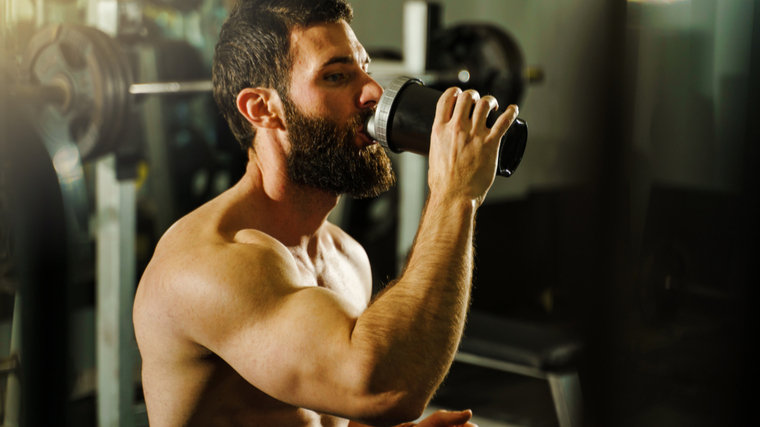Ask 100 people in the gym what their goal is, and it’s a safe bet you’ll hear “I wanna get bigger” more often than not. There’s certainly nothing wrong with wanting to transform from the proverbial weakling into a larger, stronger, more confident version of yourself. Or just build some jacked arms. That’s good, too. … Read more
The post How to Build Muscle: The Training and Diet Guide for Beginners and Advanced Lifters appeared first on Breaking Muscle.
Ask 100 people in the gym what their goal is, and it’s a safe bet you’ll hear “I wanna get bigger” more often than not. There’s certainly nothing wrong with wanting to transform from the proverbial weakling into a larger, stronger, more confident version of yourself. Or just build some jacked arms. That’s good, too. Or maybe you want a confidence boost and to improve your health. Whatever your goal, we’re here for it.
The right approach to training, combined with plenty of goal-focused eating and long-term dedication, can deliver drastic and sometimes unbelievable results. Here’s everything you need to know about building muscle.
How to Build Muscle
- How the Body Builds Muscle
- Train to Build Muscle
- Eat to Build Muscle
- Recover to Build Muscle
- Sample Muscle-Building Program
How the Body Builds Muscle
Fundamentally, building muscle comes down to stimulating and supporting “muscle protein synthesis” with specific training and nutrition practices. (1) Muscle protein synthesis (MPS) essentially means the physiological process responsible for creating new muscle tissue.
Unfortunately, it isn’t as simple as “lift weights, eat food, sleep, and grow.” While that summary does get the very rough idea across, several vital details will make or break your results.
You’re on the right track if you interpret “lift weights” to mean the more wordy-but-accurate “utilize resistance training to trigger a hypertrophy response”. You don’t need to lift “weights”, as in barbells or dumbbells.

You can apply resistance with kettlebells, resistance bands, bodyweight exercises, or oddly shaped rocks. The implement itself doesn’t matter. What you do with it — the sets, reps, training intensity, and actual exercises — will determine how much muscle growth you trigger.
Eating food to build muscle is, for many people, the fun part of adding size. It’s certainly more enjoyable to eat a hearty breakfast of steak and eggs than performing grueling high-intensity set after set in the gym.
However, over-focusing on higher calories without enough attention to the specific foods, or at least the particular macronutrients (protein, carbohydrates, and fats), will make you “bigger” without necessarily becoming “more muscular” because body fat and lean muscle tissue are two very different things.
The third leg of the growth table is sleep or, more generally, recovery. Training and recovery are two sides of the same coin. You can only recover after you’ve trained, and you can’t correctly train if you haven’t recovered.
Recovery is the least glamorous aspect of building muscle because it’s the most passive. You sleep. You spend time in the kitchen, but it’s to cook food for future meals, not to eat immediately. You don’t go to the gym. If you do go, it’s to perform low-intensity exercises like… stretching.
These types of “have to, but don’t want to” activities are what separates goal-reachers from goal-wishers. Just like you wouldn’t skip a training session or a meal and expect good results, you can’t miss a chance to recover.
Here’s a more detailed breakdown of each step on the path to more muscle.
How to Train to Build Muscle
Wanting to build muscle without exercising is like expecting groceries to just show up in your refrigerator without leaving to go to the store (or at least ordering Amazon Fresh). Despite what you might see in advertisements trying to sell you an alternative, it’s an essential step you cannot avoid.

Fortunately, there are plenty of different types of workouts and training methods that can all deliver outstanding results. Just because you want to add muscle and build your body doesn’t mean you have to train “like a bodybuilder” with stereotypical two-hour workouts six days a week.
Training Splits
Knowing your training split, or which body parts will be trained in each workout, is one of the first steps in designing a program. But before you can even get that far, you first need to know how many total workouts you will perform each week. That will determine the weekly framework for your entire plan.
Whenever you’re training for muscle growth (and, with few exceptions, training in general), more training doesn’t necessarily equate to more results. If you stick with three or four weight training workouts per week, you’re generally in a great place to get results — especially when you’re first starting.
Training only two days per week can yield some results, but not for the type of long-term approach needed to pack on quality size. Training five days per week is relatively common, with many lifters hitting the gym before or after their workday, but it’s not necessary.
Three or four workouts per week allow optimal recovery and can be structured to accommodate a number of training splits. There are three fundamental training splits that fit very effectively into a three or four-day training week.
Full body training, where all, or nearly all, muscle groups are trained in each workout; upper/lower split training, with workouts alternating focus on either the quads, hamstrings, and calves or the back, chest, shoulders, and arms; and a push/pull/legs split, training upper body “pushing muscles” like the chest, shoulders, and triceps in one workout, upper body “pulling muscles” like the back and biceps in the next workout; and the quads, hamstrings, and calves in a third workout.
These three options provide an efficient and effective structure to provide each muscle with enough weekly training and recovery for muscle growth. Training with a body part-specific split, sometimes referred to as a “bro split,” is a popular but less efficient option, specifically for a new lifter.
Some people point out that competitive bodybuilders commonly use this approach, whose sole goal is to maximize muscle growth. True. But if you’re not eating like a competitive bodybuilder and not recovering like a competitive bodybuilder, you shouldn’t be training as a competitive bodybuilder.
Training Frequency
Training frequency refers to how often an individual muscle group is directly trained each week. Just because you’re in the gym three or four days per week doesn’t mean each muscle is necessarily being trained three or four days per week. The cliche of lifters never finding time to train their legs reinforces that theory.
Training frequency isn’t a significant factor in determining results as long as a muscle is being directly trained at least once per week with proper intensity and the total weekly volume (sets and reps) is sufficient. (2) However, training with a higher frequency can be beneficial under several conditions.
First, higher frequency requires fewer sets per workout and is more time-efficient. A lifter could spend a 25-minute workout performing 12 sets for biceps on Sunday, for example. Or they could spend about six minutes per workout performing four sets on Monday, four sets on Wednesday, and four sets on Friday. You’ll get the same results, either way.
An increased training frequency also allows more body parts to be trained per workout, which falls directly in line with following any of the three suggested training splits. With each session requiring less work per body part and more body parts per session, higher frequency training gets more done in less time.
The Best Exercises to Build Muscle
Every exercise falls into one of two categories: compound (multi-joint) exercises or isolation (single-joint) exercises. As the names state, compound exercises involve more than one joint in the body being recruited to move the weight. Isolation exercises restrict movement to one joint and primarily target a single muscle.

Because more joints are involved in compound exercises, more overall muscles are activated. Examples would be the bench press moving at the shoulders and elbows, the squat moving at the hips and knees, and the pull-up moving at the shoulders and elbows. This is why compound exercises are often used when the goal is to move heavy weights and display sheer strength.
Some training programs focus exclusively on using compound exercises to work larger body parts (like the back, chest, and legs) without giving any direct attention to smaller muscles like the arms and calves, but those types of programs are relatively short-term and the lack of direct attention eventually becomes a hindrance to development.
On the opposite end of the spectrum, isolation exercises move the body at just one joint to perform an exercise. Chest flyes have movement at the shoulder, leg curls at the knee, and barbell curls at the elbow.
Any training program focused primarily on isolation exercises will be extremely inefficient due to an overwhelming number of exercises needed to sufficiently work each separate body part.
It’s also important to note that when a lifter uses incorrect form to “cheat” during an isolation exercise, more joints (and more muscle groups) are recruited to complete the exercise which reduces tension on the target muscle.
To build maximum muscle size, you need to directly train all muscle groups — back, chest, shoulders, triceps, biceps, quadriceps, hamstrings, and calves. A balanced approach incorporating both compound and isolation exercises will deliver the best results.
In any given workout, targeting a body part with one to three exercises should be sufficient to stimulate growth, depending on the size of the body part (biceps require less work than quadriceps, for example) and depending on the specific training volume (sets and reps) and intensity used in the exercises.
Sets, Reps, and Intensity
How much are you doing, and how hard are you working? That’s the nitty-gritty of the workout itself. Training volume addresses the sets and reps performed per exercise, while training intensity covers how much muscular fatigue is achieved.
Volume and intensity have an inverse relationship. You can train with high intensity, or you can train with high volume, but you can rarely do both. Attempting that type of workout will lead to burnout and/or injury.
High-intensity training means each set is brought right to the edge of muscular failure. Your muscles cannot perform one more repetition in a full range of motion without either altering technique (cheating) or reducing the weight.
Taking sets to muscular failure is beneficial for building muscle, particularly for experienced lifters. (3) This means that you’ll need to be straining, struggling, and working hard to stimulate muscle growth at some point in each set.

Training volume is determined by tracking the total reps and sets for an exercise and, in the bigger picture, for each body part. Performing pull-ups for three sets of five reps would be low volume. Doing 10 sets of 10 pull-ups would be considered high volume. Doing five sets of 10 barbell rows, five sets of 10 pull-ups, and five sets of cable rows would also be a higher volume back workout.
To make things slightly more confusing, it’s possible to have a high-volume workout consisting of low-volume exercises. For example, performing one set of 10 reps for 12 different exercises would be an example of this inefficient approach.
Moderate to higher training volume has been shown to deliver more muscle growth than lower volume training. (4) Aim to work larger muscle groups with roughly 15-20 sets per week and relatively smaller muscle groups with around 9-12 sets per week, with each set in the six to 15 rep range.
Break that weekly volume into per-workout numbers based on your training split and total number of training days. For example, training three days per week with a full body split, you could train your back, chest, and legs with five to six sets per workout while training shoulders and arms with three to four sets.
In order to balance volume and intensity, not every set should be taken to muscular failure. For optimal growth and recovery, only the last one or two sets of an exercise should reach the highest levels of fatigue and failure.
Weekly Progression
“Do the same you’ve always done and you’ll get the same you’ve always got.” That old maxim applies to the gym, too. Progressive overload is a core principle of any weight training plan, especially for muscle growth.
To continue seeing steady results, training should be progressed each week by increasing the challenge to the muscles and pushing yourself to do more. “More” can be achieved by one of three methods. Increased volume, increased load, or increased intensity.
Increasing volume is the simplest approach: Do one or more reps than you did last workout. Ideally these extra reps are added to the last set, meaning your body is under more total stress to reach muscular failure. This method shouldn’t be used indefinitely or you’d end up performing 35 time-wasting, low intensity reps per set.
Increasing load is likely the most common progression method. Everyone enjoys adding weight and getting stronger. However, when the goal is muscle growth, moving the heaviest weights possible isn’t necessary. Extremely heavy weights require performing low-rep sets, which means sufficient training volume isn’t achieved. You should always be able to work within the intended rep range.

Increasing intensity each week is another overlooked but highly effective progression method. You can make each set harder with intensity-boosting techniques like slow negatives (lowering the weight at a drastically slower speed to increase muscular tension) or drop sets (quickly reducing the weight to complete additional reps). These techniques significantly increase training stress and can require additional recovery time.
Any of the progression methods can be equally effective as long as the total volume and target rep ranges are maintained. Incorporating a combination of added reps and more weight is a time-tested approach to building muscle.
Increase reps until you reach the top end of the target rep range, and then add weight so you’re only able to perform the lowest reps in that range. Again, add reps weekly and repeat the process. For example, begin with 135 pounds for 10 reps. Add one rep each week until you’re performing 14-15 reps. From there, add five to 10 pounds, which should bring you back to performing around 10 reps and begin adding reps again, now with the heavier weight.
How to Eat to Build Muscle
Nutrition is one aspect of muscle-building that many lifters underappreciate. The right nutrition plan can mean the difference between gaining inches around your waistline or inches around your chest.

Hard-training lifters require plenty of fuel to get through intense workouts, as well as restorative nutrition to kickstart recovery after the training has triggered muscle growth. Without paying attention to your diet, building muscle becomes, literally, impossible.
Your body needs the right nutrition to support growth. Here’s how to setup a muscle-building diet.
Calories
Most lifters love the idea of eating to gain size. “Bulking season” is treated like a long-term holiday where calories can be piled in free and clear because “they’re gonna be turned to muscle.” The only problem is, there’s a line between eating for size and eating like a glutton — and it’s not as fine as you think.
Muscle growth can be sufficiently supported by taking in an extra 350 to 500 calories per day. (5) That’s a far cry from the free-for-all some “permabulkers” mistakenly believe is needed to add size.
Potentially more important for muscle growth, however, is the macronutrient breakdown of those extra calories — the protein, carbohydrates, and dietary fats in the diet.
Protein
Protein is the single most important nutrient when it comes to building muscle. Protein is the only source of amino acids, which are the structural building blocks of muscle tissue. That’s why muscle protein synthesis is critical for growth. You’re creating new muscle tissue. Eat all the carbs and fats you like, but without a proper supply of protein, there will be no new muscle.
Daily protein intake doesn’t need to be complicated. A rough guideline of one gram of protein per pound of bodyweight is a reliable rule of thumb. Research has actually shown as little as 0.74 grams of protein per pound of bodyweight to be most effective. (6) If you don’t mind the bit of added math, go for it. Rounding up to a gram won’t have any negative effects.
One important aspect of protein is the source. While animal-based proteins typically have a higher bioavailability and improved absorption rates making them highly efficient, vegetarian protein alternatives have been shown to be comparably effective when the rest of the diet’s nutrients and calories are well-planned. (7)
Carbohydrates
Carbs are a hot topic in fat loss discussions, but their role in building muscle isn’t often discussed. Think of carbs as fuel — they’ve been shown to support performance during intense training, particularly higher volume workouts. (8)
Triggering muscle growth by performing those intense workouts, and then supporting that growth with an ample diet, should deliver significant results. The key issue with carbs is how easily they can sneak into the diet and push the daily calories far above the intended level.
Focusing on whole-food sources of carbs such as fruits, root vegetables, legumes, and minimally processed grains should allow you to take in sufficient energy without a drastic excess of calories.
Fats
Dietary fats have gone from public outcast to hero and back again. While fats don’t play a direct role in building muscle, they support overall health and hormone function. (9)
Fats are much more calorie-dense than either protein or carbs, making them even more likely to push daily calories into excess unless closely monitored. Minimally processed oils, natural animal fats, and certain fruits (particularly avocado and coconut) should be the primary fat sources in a muscle-building diet.
How to Recover to Build Muscle
No matter how hard a workout is, you never actually build muscle in the gym. Your body only builds muscle once you’ve gotten home, eaten some good food, and started to rest. While grabbing a post workout shake from the gym’s smoothie bar can be a good start, it’s not enough. (10)

Overtraining is a genuine condition which can result from too much work and insufficient recovery. This, over time, leads to a lack of results and potential injury from overuse and fatigue. Fortunately, a few simple recovery methods can help to ensure major results.
Rest Days
Some lifters feel the gym is their escape from the stresses of everyday life and a day without training is unimaginable. While there’s plenty of validity to the therapeutic benefits of exercise, weight training requires a different approach. Lifting weights, essentially, breaks the body down and can’t be repeated daily unless very specific program considerations are in place.
A basic training week will include three to four training days and three to four non-training (rest) days. While total rest is the most straightforward way to ensure recovery, “active recovery” is an alternative for the lifter who just can’t sit still.
Active recovery involves lower intensity training, often cardiovascular exercise like walking, running, or biking; sports practice like basketball, tennis, or martial arts; or mobility training like yoga or similar stretching routines.
These types of active, but not brutally intense, sessions have been shown to benefit lifters both physiologically and psychologically. So it’s good for your body and your brain. (11) If a day of not training is truly unbearable, you can support your recovery by taking an easier training day.
Sleep
You sleep every night (hopefully), but if you’re getting less than seven hours, you could be hindering your recovery. Certainly some people have adapted to operating with less sleep, but research has shown seven to nine hours to be ideal for supporting athletic performance. (12) Insufficient sleep has also been shown to negatively affect hormone production, muscle mass, and strength. (13)
Sure, it’s easy to just suggest “sleep more” while the reality may involve important variables like family life and work commitments. The important takeaway is to pay specific attention to your sleeping patterns when building muscle is the goal. Any steps to improve your sleep will be worth the effort.
Sample Program to Build Muscle
You’ve learned how to build muscle, what works and what doesn’t, and why. Here’s a quick grab and go plan to get started (which, to be honest, most people probably jumped right to). The exercise listings are placeholders. Plug in any exercises that work the target body part.

Sunday
Rest. No training. Cook a few good meals to have leftovers for the week.
Monday
Upper Body Workout
- Back exercise: 4 x 10-12
- Chest exercise: 4 x 10-12
- Back exercise: 4 x 12-15
- Chest exercise: 4 x 12-15
- Shoulder exercise: 4 x 10-12
- Biceps exercise: 4 x 10-12
Tuesday
Lower Body Workout
- Hamstring exercise: 5 x 4-6
- Quadriceps exercise: 4 x 6-8
- Hamstring exercise: 4 x 8-10
- Quadriceps exercise: 5 x 8-10
- Calf exercise: 4 x 12-15
Wednesday
Cardiovascular exercise (walk, run, bike), 30 minutes.
Thursday
Upper Body Workout
- Back exercise: 4 x 6-8
- Chest exercise: 4 x 6-8
- Back exercise: 4 x 6-8
- Chest exercise: 4 x 8-10
- Shoulder exercise: 4 x 8-10
- Triceps exercise: 4 x 10-12
Friday
Lower Body Workout
- Quadriceps exercise: 5 x 10-12
- Hamstring exercise: 5×10-15
- Quadriceps exercise: 4 x 12-15
- Hamstring exercise: 4×12-15
- Calf exercise: 4 x 12-15
Saturday
Stretching or mobility exercise, 30 minutes.
Time to Get Bigger
If you’re one of those “I wanna get bigger” lifters in the gym, you’ve now got all the info you need to set up an effective plan, in the gym and outside of it, to support your gains. Get your training, nutrition, and recovery lined up, and go pack on some size.
References
- Witard OC, Bannock L, Tipton KD. Making Sense of Muscle Protein Synthesis: A Focus on Muscle Growth During Resistance Training. Int J Sport Nutr Exerc Metab. 2022 Jan 1;32(1):49-61. doi: 10.1123/ijsnem.2021-0139. Epub 2021 Oct 25. PMID: 34697259.
- Schoenfeld BJ, Grgic J, Krieger J. How many times per week should a muscle be trained to maximize muscle hypertrophy? A systematic review and meta-analysis of studies examining the effects of resistance training frequency. J Sports Sci. 2019 Jun;37(11):1286-1295. doi: 10.1080/02640414.2018.1555906. Epub 2018 Dec 17. PMID: 30558493.
- Grgic, J., Schoenfeld, B. J., Orazem, J., & Sabol, F. (2022). Effects of resistance training performed to repetition failure or non-failure on muscular strength and hypertrophy: A systematic review and meta-analysis. Journal of sport and health science, 11(2), 202–211. https://doi.org/10.1016/j.jshs.2021.01.007
- Schoenfeld, B. J., Ogborn, D., & Krieger, J. W. (2017). Dose-response relationship between weekly resistance training volume and increases in muscle mass: A systematic review and meta-analysis. Journal of sports sciences, 35(11), 1073–1082. https://doi.org/10.1080/02640414.2016.1210197
- Slater GJ, Dieter BP, Marsh DJ, Helms ER, Shaw G, Iraki J. Is an Energy Surplus Required to Maximize Skeletal Muscle Hypertrophy Associated With Resistance Training. Front Nutr. 2019 Aug 20;6:131. doi: 10.3389/fnut.2019.00131. PMID: 31482093; PMCID: PMC6710320.
- Morton RW, Murphy KT, McKellar SR, Schoenfeld BJ, Henselmans M, Helms E, Aragon AA, Devries MC, Banfield L, Krieger JW, Phillips SM. A systematic review, meta-analysis and meta-regression of the effect of protein supplementation on resistance training-induced gains in muscle mass and strength in healthy adults. Br J Sports Med. 2018 Mar;52(6):376-384. doi: 10.1136/bjsports-2017-097608. Epub 2017 Jul 11. Erratum in: Br J Sports Med. 2020 Oct;54(19):e7. PMID: 28698222; PMCID: PMC5867436.
- Pohl A, Schünemann F, Bersiner K, Gehlert S. The Impact of Vegan and Vegetarian Diets on Physical Performance and Molecular Signaling in Skeletal Muscle. Nutrients. 2021;13(11):3884. Published 2021 Oct 29. doi:10.3390/nu13113884
- Mata F, Valenzuela PL, Gimenez J, et al. Carbohydrate Availability and Physical Performance: Physiological Overview and Practical Recommendations. Nutrients. 2019;11(5):1084. Published 2019 May 16. doi:10.3390/nu11051084
- Venkatraman JT, Leddy J, Pendergast D. Dietary fats and immune status in athletes: clinical implications. Medicine and Science in Sports and Exercise. 2000 Jul;32(7 Suppl):S389-95. DOI: 10.1097/00005768-200007001-00003. PMID: 10910295.
- Stark M, Lukaszuk J, Prawitz A, Salacinski A. Protein timing and its effects on muscular hypertrophy and strength in individuals engaged in weight-training. J Int Soc Sports Nutr. 2012;9(1):54. Published 2012 Dec 14. doi:10.1186/1550-2783-9-54
- Ortiz RO Jr, Sinclair Elder AJ, Elder CL, Dawes JJ. A Systematic Review on the Effectiveness of Active Recovery Interventions on Athletic Performance of Professional-, Collegiate-, and Competitive-Level Adult Athletes. J Strength Cond Res. 2019 Aug;33(8):2275-2287. doi: 10.1519/JSC.0000000000002589. PMID: 29742750.
- Bird, Stephen P. PhD, CSCS1,2 Sleep, Recovery, and Athletic Performance, Strength and Conditioning Journal: October 2013 – Volume 35 – Issue 5 – p 43-47 doi: 10.1519/SSC.0b013e3182a62e2f
- Auyeung, T. W., Kwok, T., Leung, J., Lee, J. S., Ohlsson, C., Vandenput, L., Wing, Y. K., & Woo, J. (2015). Sleep Duration and Disturbances Were Associated With Testosterone Level, Muscle Mass, and Muscle Strength–A Cross-Sectional Study in 1274 Older Men. Journal of the American Medical Directors Association, 16(7), 630.e1–630.e6306. https://doi.org/10.1016/j.jamda.2015.04.006
Featured Image: Lebedev Roman Olegovich / Shutterstock
The post How to Build Muscle: The Training and Diet Guide for Beginners and Advanced Lifters appeared first on Breaking Muscle.






